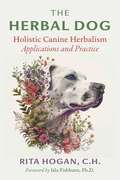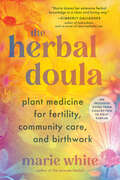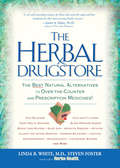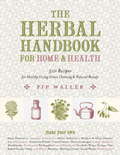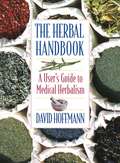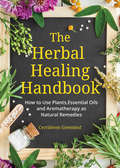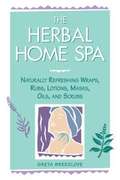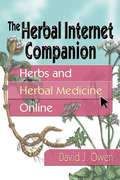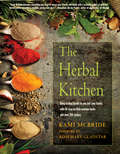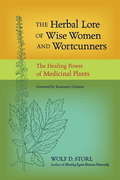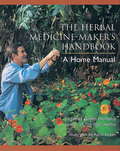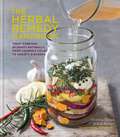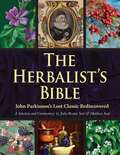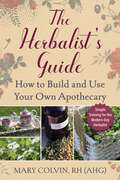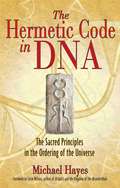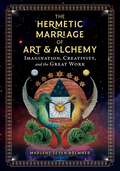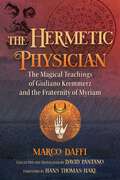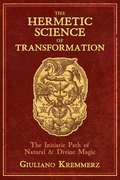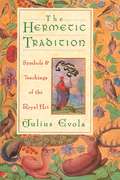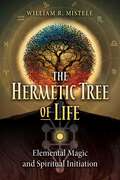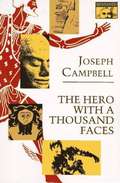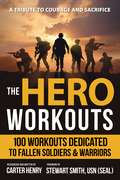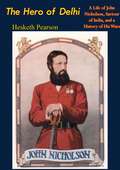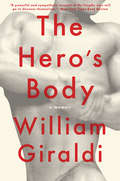- Table View
- List View
The Herbal Dog: Holistic Canine Herbalism Applications and Practice
by Rita Hogan&“Even if skeptical readers don&’t come away completely convinced, they&’ll be enormously educated—Hogan imparts a huge amount of biological information about dogs, and does it all with an easy readability that will make quite a bit of it stick. An informative and sometimes eye-opening examination of natural remedies for helping your dog.&”—Kirkus Reviews• Teaches the tenets of holistic herbalism for the individual dog• Presents safe, clinically proven, and effective protocols for common canine conditions, from acid reflux to allergies to itching, scratching, and yeast• Lays out a comprehensive materia medica of canine-specific herbs, including what conditions they are good for, their energetics, internal and external use, safe dosages, and contraindicationsIn this comprehensive guide to holistic care for dogs, clinical canine herbalist Rita Hogan explains that by looking at dogs as individual ecosystems with unique personalities, physiology, and needs, we can select effective and personalized herbal remedies to support their constitutions and provide relief from many different ailments.Hogan, who has spent more than two decades working with canines, uses energetic principles (cool, warm, dry, damp) to reveal how herbs are not "one size fits all" and how to find the root cause of chronic imbalances. She discusses in depth how a dog&’s main organ systems work, how they are connected to each other, and why we need to understand them when choosing specific herbs and foods.Presenting safe, clinically proven, and effective protocols for common canine conditions—from acid reflux to allergies to itching, scratching, and yeast—Hogan presents a wide variety of holistic and herbal remedies: from herbal tinctures, glycerities, and phytoembryonics to flower essences, essential oils, medicinal mushrooms, and homeopathy. Her comprehensive materia medica of canine-specific herbs that she uses in her practice details what herbs are good for which conditions and why, what types of energetics are involved, safe dosage recommendations for each herbal remedy, and when to discontinue an herb.Allowing each of us to take a hands-on approach to our canine companions&’ health and longevity, this herbal guide outlines how to help them live their best lives by our sides.
The Herbal Doula: Plant Medicine for Fertility, Community Care, and Birthwork--An inclusive guide from conception to postpartum
by Marie WhiteA modern, inclusive guide to plant-based reproductive medicine: herbal remedies and collective care for conception, pregnancy, birth, postpartum, and beyond30+ herbal protocols and preparations for morning sickness, fertility, and postpartum healingHerbal medicines are effective for a host of pregnancy and birth-related concerns. From nausea and mastitis to c-section wounds and fertility assistance, all-natural remedies can be used safely and effectively—and can even amplify the positive outcomes of conventional reproductive medicine treatments. Yet many women and birthing people don&’t know where to start, or how to find reliable information that&’s vetted, trustworthy, and—most importantly—safe for their fertility, babies, and babies-to-be.The Herbal Doula demystifies herbal reproductive care, offering open and expert guidance in being your own budding fertility, conception, and pregnancy doula—or supplementing your existing care plan with your midwife, doula, or physician. Practical chapters explore:Herbs for fertility, infertility, and inclusive conceptionHerbal remedies for common pregnancy side effects like nausea, heartburn, constipation, hemorrhoids, edema, UTIs, fatigue, and prenatal mood swingsMiscarriage, abortion, and caring for yourself after pregnancy lossHerbs for the fourth trimester: perineal injuries, C-section wounds, breast care, and postpartum depressionHerbal approaches to breastfeeding and chestfeeding: increasing and decreasing milk supply, plugged ducts, and mastitisHow, when, and when not to use herbs while pregnant and breastfeedingHow to source, store, and use herbs safelyCare and herbal medicine for doulas and birthworkersA doula&’s essential materia medicaWhile many traditional herbals rely on outdated gender norms, classist assumptions, or problematic standards of care, The Herbal Doula is written for readers of all genders and body types, approaching herbal care with a HAES (health at every size) lens. It celebrates herbal pregnancy and birth work as collective care, recognizing chosen family, disability dignity, and the importance of daily practice in a guide you&’ll return to again and again throughout any and all stages of your journey.
The Herbal Drugstore: The Best Natural Alternatives to Over-the-Counter and Prescription Medicines!
by Steven Foster Linda B. White The Staff Of Herbs For HealthEase Symptoms, Fight Disease, and Supercharge Immunity--All Without Drugs or Chemicals! You're about to enter a completely different kind of drugstore. One where herbal medicines are offered right alongside conventional pharmaceuticals. Where bottles of feverfew stand next to bottles of aspirin, and echinacea has its place among other cold and flu remedies.The Herbal Drugstore is the only place where you can compare mainstream drug treatments and their herbal alternatives for close to 100 common health problems. You'll find herbs that have the same healing powers as many prescription and over-the-counter medications--only they're cheaper and gentler, with few or no side effects.Whether you need fast first-aid or long-term relief, The Herbal Drugstore has a remedy for you. Here's just a sampling:* Immobilized by arthritis? Rub on capsaicin cream, a natural pain reliever made from hot peppers* Can't sleep? Start snoozing with valerian--it's as effective as Valium, but it isn't addictive* Want to lose a few pounds? Get a helping hand from psyllium, an herbal alternative to appetite suppressants* Feeling stressed? Calm jangled nerves with ginseng--it won't undermine alertness* Battling bronchitis? Clear up that cough with licorice, a natural expectorant* Need help with high blood pressure? Turn to hawthorn--it has much in common with beta blockers, except for the side effectsThe Herbal Drugstore features these and many more herbal remedies--712 in all! They're profiled right next to their pharmaceutical counterparts, so you can make your own comparisons and decide which treatments are best for you.
The Herbal Handbook for Home and Health
by Pip WallerKitchen pharmacy meets green cleaning and natural beauty in this comprehensive handbook of 501 recipes that harness the power of plants to enhance wellness and toxin-free living. Expert herbalist Pip Waller provides a wealth of information about growing, collecting, preserving, and preparing herbs for a variety of purposes--from cleaning products, to food and drink, medicines, beauty products, and more. Attractive and easy to use, The Herbal Handbook for Home and Health includes growing tips and profiles of herbs, guidelines for setting up an herbalist's kitchen, and techniques to make everything from tinctures to tonics. A valuable resource for anyone affected by allergies or sensitivities, this compendium is handsomely produced with two-color printing throughout and more than three hundred striking illustrations.The Handbook includes contributions from herbalists from around the world and encompasses recipes that range from very simple to more complex. Seasoned herbalists as well as those just beginning to explore the world of herbs will find something to start their own nontoxic, non-allergenic domestic revolution.The book includes: * A history of herbal lore * The herbalist's kitchen--equipment and procedures for harnessing the power of plants * Green cleaning products (from floor wax to stain removers) * Herbal pharmacy (from throat lozenges to hangover cures) * Nutritional supplements and detoxes * First aid (from anti-anxiety drops to bruise ointment) * For travel (insect repellant to anti-nausea drops) * Food and drink (breads, butters, wines, teas) * Beauty and balms (toothpaste to shampoo to lip balm) * Kitchen Pharmacy * Food & Drink * Beauty, Balms & Personal Care
The Herbal Handbook: A User's Guide to Medical Herbalism
by David HoffmannWell-respected herbalist David Hoffmann's comprehensive and practical guide to herbal medicine. • Discusses the history and modern practice of herbalism, including Chinese, Native American, and Welsh influences. • Includes a practical reference section listing the effects of various herbs, with prescriptions on how to use them for a wide range of illnesses. • Covers the fundamentals of growing, drying, storing, and cooking with herbs. • Over 45,000 copies of previous edition sold. This compendium of medical herbalism by one of the most eminent herbalists practicing today is both comprehensive and practical. Answering basic as well as complicated questions about herbal medicine, it provides both the novice and the experienced practitioner with a reliable framework in which to develop their herbal skills. A discussion of the history and modern practice of herbalism, encompassing the influences of Welsh, Chinese, and Native American herbal medicine is followed by a practical reference section that lists the various actions herbs have on the body (carminative, anti-inflammatory, etc.), with examples of herbs and their mode of activity in each category. Herbal prescriptions for various illnesses are also organized under the main systems of the body so that information can be quickly and easily referenced. A final section covers the fundamentals of growing, drying storing and cooking with herbs, as well as the making of infusions, decoctions, oils, and ointments. The author also provides helpful introductions to aromatherapy and plant medicines.
The Herbal Healing Handbook: How to Use Plants, Essential Oils and Aromatherapy as Natural Remedies
by Cerridwen GreenleafA spiritual guidebook to treating ailments and preventing illness using plants, essential oils, aromatherapy, and other natural elements.Bestselling author Cerridwen Greenleaf shares the healing power of plants, roots, herbs, essential oils, aromatherapy, and all things natural remedies. If you are tired of automatically turning to chemical treatments, or just want to have more plant-based care options, The Herbal Healing Handbook is the book for you.While health care debates rage all around us, one way to take good care of yourself and your loved ones is with the “kitchen cabinet cures” in this book. When our great grandmothers needed to attend to the cuts, bruises, colds, flu’s fevers, and other illnesses their family suffered, they didn’t have a corner drugstore. Instead, these wise women relied on simple wisdom, common sense, and pantries well stocked with herbal remedies. These preparations were made from plants that grew in the kitchen garden or wild weeds gathered outside. The Herbal Healing Handbook combines the wisdom of our elders with a modern kitchen herbalist’s sensibility.In The Herbal Healing Handbook you will:Learn about natural remedies you can make yourselfTreat inflammation and painBuild energyImprove your attitude and mindsetGain key knowledge about plants, roots, essential oils, and aromatherapyPerfect for readers of The Healing Power of Essential Oils, Encyclopedia of Herbal Medicine,or The Green Witch.
The Herbal Home Spa: Naturally Refreshing Wraps, Rubs, Lotions, Masks, Oils, and Scrubs
by Greta BreedloveThis book tells all about how to make easy, affordable, and effective herbal spa treatments at home. Covers treatments for the hair, scalp, skin, cosmetics, body lotions and wraps, and more. Gives hints on where to find the ingredients, basic uses of herbs and other ingredients, and hints on ways to "tweak" the recipes to make them totally personalized to your needs and for gift giving.
The Herbal Internet Companion: Herbs and Herbal Medicine Online
by David J OwenThis valuable and timely book (Winner of the International Herb Association's 2002 Book Award!) will help you navigate the sea of information about herbs and herbal remedies on the Internet. Besides listing hundreds of reliable Internet sites and what you'll find there, it discusses criteria for assessing the quality of health information on the Internet. This book will show you how to find: mailing lists, chat rooms, and newsgroups providing herbal information; answers to specific consumer/patient questions; information about laws, standards, and regulations governing herbal products; organizations dealing with herbal medicine; consumer protection, health fraud, and quackery; Internet resources in specialized health areas such as cancer and AIDS; online indexes and databases such as MEDLINE; and much more! Complete with easy-to-read tables and charts as well as a glossary of terms you'll encounter on these Web sites, The Herbal Internet Companion: Herbs and Herbal Medicine Online is the resource that puts the power of the Internet in your hands!To view an excerpt online, find the book in our QuickSearch catalog at www.HaworthPress.com.
The Herbal Kitchen: Bring Lasting Health to You and Your Family with 50 Easy-To-Find Common Herbs and Over 250 Recipes
by Kami McBride"Kami McBride provides everything you need to amaze your friends and family with a seasonal bounty of delicious herbal drinks, smoothies, cordials, pestos and more." -- Rosalee de la Forêt, author of Alchemy of Herbs <P><P>Herbs are a gift from nature. They not only help to create aromatic and delicious food, they also support overall health and wellness on a daily basis. Using dried and fresh herbs in your cooking boosts your intake of vitamins and minerals, improves digestion, strengthens immunity, and increases energy. Using plants as medicine is an ancient and powerful tradition that connects you to the earth, helps treat common ailments, promote restful sleep, relaxation, and more. <P><P>The Herbal Kitchen will help you recognize the extraordinary pharmacy that probably already exists in your own kitchen. With 50 easy-to-find herbs and spices, information and tips for preparing, storing, and using them, and over 250 simple, flavorful recipes, it will empower you to care for your health.Whether you are already familiar with herbs or are just starting out on the herbal path, Kami McBride offers recipes for everyone. Mix up refreshing drinks, infuse oil, vinegar and honey, learn how to make tinctures and cordials, salts, sprinkles, and more.
The Herbal Lore of Wise Women and Wortcunners
by Rosemary Gladstar Wolf D. StorlTraditional herbalists or wise women were not only good botanists or pharmacologists; they were also shamanic practitioners and keepers of occult knowledge about the powerful properties of plants. Traveling back to the healing arts of the ancient Egyptians, Greeks, and Romans, The Herbal Lore of Wise Women and Wortcunners takes readers deep into this world, through the leechcraft of heathen society and witches' herb bundles to the cloister gardens of the Middle Ages. It also examines herbal medicine today in the traditional Chinese apothecary, the Indian ayurvedic system, homeopathy, and Native American medicine. Balancing the mystical with the practical, author Wolf Storl explains how to become an herbalist, from collecting material to distilling and administering medicines. He includes authoritative advice on herb gardening, as well as a holistic inventory of plants used for purposes both benign and malign, from herbs for cooking, healing, beauty, and body care to psychedelic plants, witches' salves for opening alternative realities, and poisonous herbs that can induce madness or cause death. Storl also describes traditional "women's plants" and their uses: dyeing cloth, spinning and weaving, or whipping up love potions. The Herbal Lore of Wise Women and Wortcunners is written for professional and amateur herbalists as well as gardeners, urban homesteaders, and plantspeople interested in these rich ancient traditions.
The Herbal Medicine-Maker's Handbook: A Home Manual
by James GreenTHE HERBAL MEDICINE-MAKER'S HANDBOOK is an entertaining compilation of natural home remedies written by one of the great herbalists, James Green, author of the best-selling THE MALE HERBAL. Writing in a delightfully personal and down-home style, Green emphasizes the point that herbal medicine-making is fundamental to every culture on the planet and is accessible to everyone. So, first head into the garden and learn to harvest your own herbs, and then head into your kitchen and whip up a batch of raspberry cough syrup, or perhaps a soothing elixir to erase the daily stresses of modern life.
The Herbal Remedy Handbook: Treat everyday ailments naturally, from coughs & colds to anxiety & eczema
by Kim Walker Vicky ChownWith self-care, mindfulness and mental health being at the forefront of the popular consciousness, taking control of your health has never felt so important. And learning about herbs and how they can treat and heal ailments and conditions is a good place to start.The Herbal Remedy Handbook is a collection of practical remedies for home care. It is an ailment and recipe-led reference for first-aid, simple conditions such as coughs and colds, and helpful self-management techniques for more complex conditions such as anxiety and eczema. From vinegars and tonics, creams and balms to syrups and teas, all the recipes use easily accessible, bought, foraged or grown ingredients for you to create your own herbal healthkit.An indispensable guide for the beginner or the budding herbalist, The Herbal Remedy Handbook is filled with tried-and-tested recipes that will inspire you to make your own remedies.
The Herbalist's Bible: John Parkinson's Lost Classic Rediscovered
by Julie Bruton-Seal Matthew SealA lost classic of Western herbalism-rediscovered and restored with 200 full-color images.Herbalist to King Charles I, John Parkinson (1567-1650) was a master apothecary, herbalist, and gardener. Famous in his own lifetime for his influential books, his magnum opus, the Theatrum Botanicum, was published in 1640 and ran to 1,766 large pages. The sheer scope and size was perhaps to prove the book's downfall, because while it was much revered-and plagiarized-it was never reprinted and, centuries later, has attained the status of an extremely rare and valuable book. Parkinson was writing at a time when Western herbalism was at its zenith, and his skills as a gardener (from his grounds in Covent Garden) combined perfectly with his passion for science, observation, and historical scholarship.In the The Herbalist's Bible, Julie Bruton-Seal and Matthew Seal have beautifully combined selections from Parkinson's book with their own modern commentary on how each plant is used today to create a truly one-of-a-kind, comprehensive collection of herbal information old and new. Parkinson's clear and lively description of a chosen plant's "vertues" or healing properties side-by-side with the editors' notes-including copious herbal recipes-make this the perfect book for students and practitioners of herbalism, historians, and gardeners, all of whom will welcome this restoration of Parkinson's lost classic.
The Herbalist's Guide: How to Build and Use Your Own Apothecary
by Mary ColvinCreate the home apothecary of your dreams! With a little bit of knowledge, Mary Colvin, RH (AHG) believes that anyone can develop their own homemade remedies and medicines. In The Herbalist&’s Guide, she introduces you to the world of herbalism and shares her own knowledge about herbal actions, the concept of energetics and its importance in herbalism, basic botany, harvesting, herbal preparations, miscellaneous materials used to make herbal medicine, and other tools of the trade. Chapters include full-color photos for identification and come with exercises for information retention, suggestions for additional reading and education, and recipes for simple remedies. By the end of this book, you will come away with: An understanding of herbalism basics Guidance to experiment with thirty-five commonly used herbs All the information you need to practice safely and effectively A fully stocked home medicine chest And so much more! Grow your own herbs and be armed with natural solutions to help heal your family from everyday issues with The Herbalist&’s Guide.
The Hermetic Code in DNA: The Sacred Principles in the Ordering of the Universe
by Colin Wilson Michael HayesAn examination of the precise code that connects ancient spirituality with modern science • Shows how the numerical patterns in ancient philosophies are evident in both the structure of the universe and the helical structure of DNA • Reveals that music theory comes from an intuitive understanding of the resonant harmony of the cosmos Many have observed the distinct numerical patterns embedded in ancient philosophies and religions from all over the world; others have noted that these same patterns are apparent in many of the theories of groundbreaking science. Michael Hayes reveals that there is a precise code, the Hermetic Code, that connects these patterns--information once known to ancient cultures but apparently lost over time. Mirrored in the structure of this code are the ordering principles of the universe and, intriguingly, also the harmonic ratios of music. Our notions of what is harmonious in music may therefore arise not from an abstract aesthetic sense but as a response to an intuition of a fundamental cosmic harmony.The resonance between biology and cosmology shows that life is music, complete with “overtones”--nowhere more strikingly present than in the helical structure of life itself: DNA.
The Hermetic Marriage of Art and Alchemy: Imagination, Creativity, and the Great Work
by Marlene Seven BremnerAn initiatory and practical guide to creative alchemy• Shares hermetic and alchemical techniques for liberating creative expression and looks at the zodiacal and planetary timing of creative operations• Explains how to work with and transmute alchemical energies for increased levels of insight, intuition, and imaginative expression• Explores the connections between Surrealism and alchemy, as well as the rich and complicated symbolism of alchemical artIn this initiatory guide to the Hermetic art of alchemy, artist Marlene Seven Bremner reveals how the alchemical opus, the Great Work, offers a practical means for liberating the authentic creator within and attaining gnosis, or true self-knowledge. Exploring the connections between Surrealism and alchemy, as well as the rich and complicated symbolism of alchemical art, Bremner elucidates how both Surrealism and alchemy seek to unfetter the imagination and dissolve the boundaries between dream and reality, thus reconciling the conscious and unconscious minds. She details how the three principles (salt, sulfur, and mercury), the four elements, and the seven planets interact together and within the self in creative alchemy, and she explains how to work with and transmute these energies for increased levels of insight, intuition, and imaginative expression. The author shares practical Hermetic and alchemical techniques for liberating creative expression and clearing energetic obstructions that prevent us from reaching our higher potential. She also looks at the zodiacal and planetary timing of creative operations. Revealing how the stages of alchemical transmutation are relevant to the creative process, the author shows how the initiate comes to experience for themselves the relationship between consciousness and matter, which is the essence of alchemical teachings. By creating, one transmutes spiritual energies through matter for greater self-knowledge and awakening.Allowing you to truly realize your own creative power, this in-depth guide to creative alchemy shows how the alchemical path attunes the Self to the rhythms of the spheres so that one is naturally creating in time with the seasons and zodiac signs and in harmony with elemental forces and planetary influences
The Hermetic Physician: The Magical Teachings of Giuliano Kremmerz and the Fraternity of Myriam
by Marco Daffi• Explores Kremmerz&’s life, his teachings, his work as a hermetic physician, and the metaphysical and hermetic principles that guided his activities • Offers a detailed account of the distance healing practices, diagnostic methods, and rituals of the Fraternity of Myriam • Includes texts written by Kremmerz on the inner workings and magical operations of the fraternity, intended for its practicing members Giuliano Kremmerz (1861-1930), born Ciro Formisano, was one of the most influential Italian occultists, alchemists, and Hermetic masters of the late nineteenth and early twentieth centuries, though he remains almost unknown to English readers. In 1896, Kremmerz began writing about natural and divine magic, healing, and alchemy through the journal Il Mondo Secreto (The Secret World). At the same time, he founded a school known as the Schola Philosophica Hermetica Classica Italica as well as a magical group, the Therapeutic and Magical Fraternity of Myriam. Within the Myriam, he sought to use Hermetic, magical, and Pythagorean principles to harness the power of the psyche and convey collective energies for therapeutic purposes and distance healing. His initiatic order would become the principal esoteric society in Italy--comparable to its British counterpart, the Hermetic Order of the Golden Dawn--but forced to be a carefully guarded secret as Mussolini&’s government rose to power. In this unique compilation of essays, David Pantano presents an in-depth study of Kremmerz&’s life and work by his student and initiate, Italian esotericist Marco Daffi. Without holding back criticism, Daffi provides a detailed account of the history and practices of the Myriam as well as the metaphysical and Hermetic principles that guided their activities. Revealing Kremmerz&’s rediscovery of the occult healing of ancient mystery schools, Daffi also shows how Kremmerz laid the foundation for passing this initiatory tradition on to the new millennium. He explores the means by which Kremmerz said miracles can be performed and the way Hermetic forces affect both bodily health and mystical eroticism. Throughout this collection, David Pantano provides extensive annotations, offering the English reader essential historical and mystical context for Daffi&’s work. Connecting to untranslated Italian texts and elucidating Daffi&’s poetic style, Pantano&’s commentary reveals the particular tradition of Italian esoterism. Pantano also includes rare and unpublished texts written by Kremmerz and intended for the Myriam&’s practicing members. Combined, these papers offer a picture of the inner workings and magical operations of this fraternity, available for the first time in English.
The Hermetic Science of Transformation: The Initiatic Path of Natural and Divine Magic
by Giuliano KremmerzA classic initiatic primer for the serious magical aspirant, available now for the first time in English • Details occult purification and preparations for the path of natural and divine magic • Explains how initiation into the hermetic science transforms the novice not only mentally but also physically, altering even the very fluids of the body • Offers a return to the original hermetic path of initiation, following the strict procedures and symbolism as defined in the spiritual practices of Pythagoras and his tradition The main purpose of the hermetic science, as seen by Giuliano Kremmerz (1861-1930), Italian alchemist, hermeticist, philosopher, and member of the Ur Group, is to allow the adept to concentrate on the natural and divine magic that will allow him or her to develop the latent powers innate in every human being. The initiatory path this opens, one the author compares to the Royal Way of Alchemy, transforms the novice not only mentally but also physically, altering even the very fluids of his or her body. For Kremmerz, magic is the supreme science, the highest expression of what exists and what is possible. With this book, first published in Italian in 1897 and available here for the first time in English, Kremmerz sought to redefine magical initiation as well as other key components of the occult sciences. His aim was to bring the hermetic path of initiation back into alignment with the strict procedures and symbolism that defined the spiritual practices of Pythagoras and the heirs to his tradition. He visualized the initiate as a disciple who has escaped the stagnant water in which the rest of humanity is immersed and entered a state of non-ordinary consciousness, one that allows for the successful pursuit of realization and contact with the magical will. In this transformative initiatory guide, Kremmerz details the occult purification and preparation the path of natural and divine magic requires. The spiritual course advocated by Kremmerz is arduous--to move forward on the path of true realization, one that will allow the initiate to &“climb to heaven&” while still alive, the aspirant must commit to total severance from everyday life. Yet Kremmerz&’s words themselves serve to trigger the beginning of transformation within us, making the very act of reading this primer the first step on the path of initiation into the hermetic science.
The Hermetic Tradition: Symbols and Teachings of the Royal Art
by Julius EvolaThis important survey of alchemical symbols and doctrines sets forth the mysterious worldview and teachings of the practitioners of the "royal art." One of the leading exponents of the Hermetic tradition, Julius Evola demonstrates the singularity of subject matter that lies behind the words of all adepts in all ages, showing how alchemy--often misunderstood as primitive chemistry or a mere template for the Jungian process of "individuation"--is nothing less than a universal secret science of human and natural transformation. First published in 1931 in Italian. This is the first English translation. Draws from a host of sources in the Western esoteric tradition--works on theurgy, magic, and gnosticism from neoplatonic, Arab, and medieval sources.
The Hermetic Tree of Life: Elemental Magic and Spiritual Initiation
by William R. MisteleA guide to realizing your highest magical and spiritual potential• Provides initiatory wisdom and practices structured around the Tree of Life to maximize spiritual powers and creativity • Presents strategies for self-actualization drawn from transpersonal psychology, spirituality, Gaia-based religions, the Western hermetic tradition, Kabbalah, and other mystical traditions, including the teachings of Franz Bardon • Offers practices for enhancing connection to one&’s higher self, exploring dreamtime on the astral plane, dissolving negativity, and developing mental clarity In initiation, something happens to us. We change. Some aspect of ourselves is transformed. The result is that the various forces within us—desires, dreams, motivations, and inspirations—are amplified, deepened, and redirected. Ultimately, the goal is to become your own creation, your better self, the person you wish to be. In this accessible guide to realizing your highest magical and spiritual potential, William Mistele presents a wealth of practices and initiatory wisdom, structured around the Tree of Life, to help you develop the vast spiritual world within. Drawing on hermetic teachings, the Kabbalah, and the elemental magic of Franz Bardon, he provides psychological skills to master, dreams to explore, and initiations to experience. His methods enhance sensory perception and deepen feelings of peace and oneness with the universe. He shares practices for learning to talk to and gain the cooperation of your subconscious, techniques for dissolving negativity, ways to create bliss and ecstasy at will, and the means for enhancing a connection to one&’s higher self. For each of the ten sephiroth of the Tree of Life, progressing from the sephirah connected to the physical world to those connected to the astral plane, enlightenment, and the higher self, Mistele explores each sephirah&’s unique spiritual qualities and wisdom and offers challenges for the reader to accomplish and magical methods to unite oneself with the four elements of nature (earth, air, fire, and water) from within. He shares profound psychological and spiritual experiences that can occur once you know a sephirah deeply and explains exactly how you can reproduce these experiences for yourself. Offering initiatory practices to help you enact transformation at the core of your being, he guides you to bring each sephirah to life via visualization and dreams. Providing a roadmap to the spiritual world, Mistele empowers you to have more self-understanding, to be more successful and confident, and to have the imagination and spiritual freedom to transform into the person you wish to be.
The Hero With a Thousand Faces
by Joseph CampbellThe first popular work to combine the spiritual and psychological insights of modern psychoanalysis with the archetypes of world mythology, the book creates a roadmap for navigating the frustrating path of contemporary life.
The Hero Within: Six Archetypes We Live By
by Carol PearsonUses Jungian heros to explore how these figures exist within each of our lives and can be the means for deepening our understanding and enriching our experience of life.
The Hero Workouts: 100 Workouts Dedicated to Fallen Soldiers & Warriors
by Stewart Smith Carter HenryThe Hero Workouts presents a collection of exercise routines honoring the valiant men and women who gave their lives in service to their country. Each workout is dedicated to a fallen hero and includes the true account of their life and service. Bell, Gallant, Pike, Legion 8, Jenny. These are the names of workouts created as a tribute to men and women who lost their lives in service to their country. A new book, The Hero Workouts presents a definitive collection these honorific workouts dedicated to their memory. The Hero Workouts features over 100 workouts each named for a fallen hero and includes the story of their personal lives and battle action. The story behind the Hero Workouts is one that needs to be told. Each workout is named after a fallen soldier or group of soldiers. Just among the selection include Bell, Gallant, Pike, Legion 8, Full Maltz, Griff, Bull, Willy, Joshie, Gator, The Don, Operation Red Wings, Murph, JT, Luce, 31Heroes, Faas Fit, Big Andy, The Jonas Project Memorial WOD, Indian 617, JAG 28, Rocket, Jenny, War Frank, Badger... and more than 100 are featured in The Hero Workouts. Started in the Crossfit community, the Hero Workouts are rooted in honor. By participating in these workouts, one gains the opportunity to revere an individual who has made the ultimate sacrifice. Taking the time to remember these men and women or to learn who they were can be part of a healing process, either on a personal level or in response to a collective loss we all feel. The stories behind the workouts are emotional and moving... stories of courage, family, loss, and grief collected and expressed by researcher and writer Carter Henry, herself an active duty sailor in the United States Navy. Carter Henry has agreed to donate 100% of her earnings from the sale of The Hero Workouts to benefit the Special Operations Warrior Foundation (SOWF). SOWF provides college scholarships for the surviving children of fallen Special Operations Forces, family & educational counseling, and financial grants to severely-wounded Special Operations Forces service members. The Hero Workouts is an exceptional publication, unique and inspirational, one every American should read and reflect upon.
The Hero of Delhi: A Life of John Nicholson, Saviour of India, and a History of His Wars
by Hesketh PearsonAn Irishman, like so many other great British generals, John Nicholson received a cadetship in the Bengal Infantry at the age of sixteen. Apart from one short visit to England, the rest of his life was spent in India. The Afghan and Sikh wars of the eighteen-forties brought out the titanic powers of a character that “flowered in action,” and before he was thirty, “Nikal Seyn” was a legend throughout India, a god to the Sikhs and to certain fakirs who called themselves Nikal-seynites, and a thorn in the side of incompetent and idle officials of the British Government. In an unquiet country where quick movement was the secret of military success against an elusive enemy, Nicholson’s energy, even more than his absolute personal courage, was the factor that made him the most powerful instrument of British policy in India. Passionately sincere, arrogantly self-confident, insubordinate without remorse when he saw cause, and always in the right, Nicholson provoked no ordinary emotions. He was loved, admired, feared, envied, and hated in the most violent degree.The climax of his career was the Indian Mutiny. Very seldom in history have the man and the task matched each other so notably. “Mutiny is like small-pox,” he said. “It spreads quickly and must be crushed at once.” Not all his superiors thought the same, but when he had freed himself from the trammels of authority he saved the Punjab, and so India, by sheer exertion. It is a breathless story of march, surprise, and counter-march, thrusting quickly into the hills and as quickly back to Peshawar, the danger-spot. When that situation was under control he marched to Delhi, where his arrival transformed the rôle of the British troops from besieged to assaulters. The assault succeeded but cost Nicholson his life. He was thirty-four years old, a general, and “the idol of all soldiers.”
The Hero's Body: A Memoir
by William GiraldiA memoir of motorcycles and muscles, of obsession and grief, and of a young man who learned how to stay alive through literature. At just forty-seven years old, William Giraldi’s father was killed in a horrific motorcycle crash while racing on a country road. This tragedy, which forever altered the young Giraldi and devastated his family, provides the pulse for The Hero’s Body. In the tradition of Andre Dubus III’s Townie, this is a deep-seeing investigation into two generations of men from the working-class town of Manville, New Jersey, including Giraldi’s own forays into obsessive bodybuilding as a teenager desperate to be worthy of his family’s pitiless, exacting codes of manhood. Lauded by The New Yorker for his “unrelenting, perfectly paced prose,” Giraldi writes here with daring, searing honesty about the fragility and might of the American male. An unflinching memoir of luminous sorrow, a son’s tale of a lost father and the ancient family strictures of extreme masculinity, The Hero’s Body is a work of lasting beauty by one of our most fearless writers.
